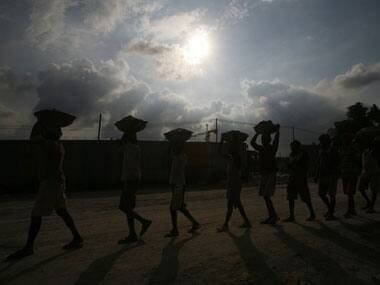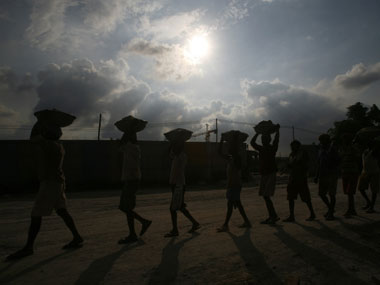SOS to the government: Stop dithering and placing the burden of reviving economic growth on the central bank. If there was ever a time to introduce a fresh wave of high-impact economic reforms, it’s now**.** Especially since the central bank has very little leeway to do anything itself.
The slowdown signs were already visible to several investors; now even the Reserve Bank of India (RBI) has officially acknowledged them and warned that economic growth could slow even further in the coming months, even as inflation remains persistently high.
In its annual report released Thursday, the central bank said growth could likely moderate to around the estimated 8 percent in the 12 months to March 2012, but warned there was a “downward bias” if global uncertainties continued.
Inflation, the big headache for the economy, refuses to go away, despite the central bank administering repeated - and increasingly strong - doses of interest rate hikes. Even after 11 interest rates increases since March 2010, inflation remains stubbornly above 9 percent. The central bank expects high prices to continue until the second half of the financial year (April-March), when it expects prices to cool to about 7 percent.
High interest rates have chipped away at economic growth. Industrial growth has slackened, while consumer demand has slipped, which, in turn, has diminished appetite for corporate investment and expansion. In addition, companies have been batting high input costs caused by high global commodity prices.
Not surprisingly, in the past few months, several foreign and local brokerages have downgraded corporate earnings and benchmark index estimates for this financial year. The latest was CLSA, which cuts its year-end Sensex target by 7 percent to 18,200 on Thursday. “While the sharp correction in the market may suggest attractive valuations, we note the pace of corporate earnings downgrades has intensified in the recent results season,” said CLSA in its report released this week. “We lower 12 month Sensex target to 18,200 as we lower the target multiple to 13x to factor in the earnings downgrade risk,” the Swiss brokerage noted in a strategy report.
According to Bloomberg data, earnings for 46 percent of Sensex companies missed analyst estimates in the June-ending quarter. That compares with 33 percent in the previous quarter.
Insulated. Really?
[caption id=“attachment_70009” align=“alignleft” width=“380” caption=“While RBI can tackle demand levels through monetary policy; the economy also sorely needs investments in agriculture and other areas to boost supplies of different goods. Reuters”]
 [/caption]
[/caption]
The argument that the Indian economy is insulated from the global turmoil (a fading US recovery and spreading debt contagion in Europe) is also flawed. In recent years, several Indian companies have been generating an increasing proportion of income from overseas operations. In fact, more than half of the Sensex’s earnings in the year ending March 2012 is expected to be generated from overseas. Reliance Industries, an index constituent, for instance, gets about 60 percent of its revenue from international sales, while Tata Motors gets 53 percent. Software exporter Infosys gets 97 percent of its income from international operations. So to argue that Indian companies will not be affected by the ongoing global economic turmoil is simply wrong.
Another worrying thing: so far, most corporate earnings downgrades have occurred taking into account domestic factors, such as high input prices, high interest rates and slowing consumer demand. Now, further downgrades in earnings could arise because of the “global” operations of Indian companies, according to some experts.
Meanwhile, exports, after having a good run in the past few months, are predicted to decline as well.
So, to sum up, the economy is fighting high prices, high interest rates, slowing industrial growth, faltering exports, and growing global economic uncertainty all at the same time. Plus, the impasse between Team Anna and the government (which, hopefully, might get resolved soon) has put the spotlight on rampant corruption in the country, further dampening investor sentiment.
Yet, the government continues to insist that our economy is ‘robust’ and that the growth story remains intact.
Time for action
Unfortunately, that puts pressure on the RBI to “do something” to fix the economy, which it simply cannot do at this time. Recent statements by top officials suggest that fighting inflation remains the bank’s key priority, even at the risk of cooling growth. For now, the RBI doesn’t mind slower growth because subsiding domestic demand will help in controlling inflation.
The central bank might, at best, be able to hold off on any further rate hikes after raising rates one last time on 16 September, but that will do nothing to spur growth. Besides, growth is not solely dependent on interest rate hikes or cuts: it also requires a good policy mix to encourage investment in various sectors.
After all, high demand is not the only trigger for inflation; a lack of supply can also fuel high prices, especially in food products. While the RBI can tackle demand levels through monetary policy; the economy also sorely needs investments in agriculture and other areas to boost supplies of different goods. That requires the government to provide attractive and intelligent investment and tax policies.
Given that the RBI has done its part to cool demand, the government should now focus on improving supply. Making soothing statements on the economy simply don’t cut it anymore. A second wave of liberalisation, 1990-91 style, could influence positive investor sentiment and potentially drive growth for the long term, and allow us to take charge of our own economic destiny. The alternative, of course, is to whine and complain about the external environment and blame the ‘foreign hand’ for our sluggish growth - and do nothing.
What will the government choose?
)